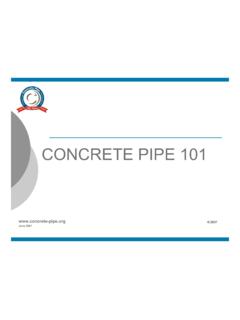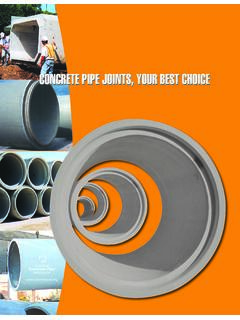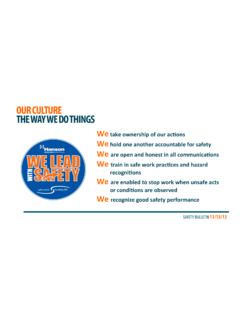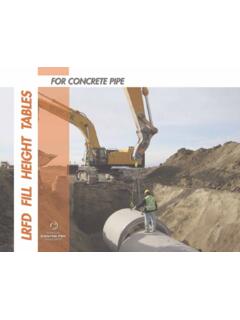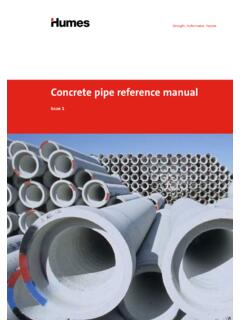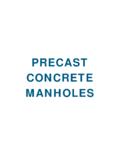Transcription of American Concrete Pipe Association An Introduction to …
1 American Concrete pipe AssociationAn Introduction to American Concrete pipe AssociationASTM Concrete pipe & Box culvert Joint& Box culvert Joint StandardsStandardsBy Eric Carleton, Eric Carleton, P. E .Independent Concrete pipe CompanyASTM C13 Anderson The Real RCP Joints t i ASTM?What is ASTM? American Society for Testing and Materials,established in 1898 ASTM International A voluntary consensus based organization which establishes tilt dd t tit lmaterial standards or testing protocols American Section of the International Association for Testing Materials. The members grappled with two questions that were widely discussed throughout the engineering community at thewidely discussed throughout the engineering community at the turn of the century.
2 First, how could standards for materials contribute to industrial progress? And second, how could producers and users of industrial materials reach a consensus on standards ?ASTM s early history was in on standards ?ASTM s early history was in large part a quest to find answers to these pivotal questions4 Weakest Link of ConduitWeakest Link of Conduit5 ASTM C76 Standard Sifi tifR i fd5 Specification for Reinforced Concrete culvert , Storm Drain, and Sewer C76 Standard Sifi tifR i fd6 Specification for Reinforced Concrete culvert , Storm Drain, and Sewer C76 Standard Sifi tifR i fd7 Specification for Reinforced Concrete culvert , Storm Drain, and Sewer C76 Standard Sifi tifR i fd8 Specification for Reinforced Concrete culvert , Storm Drain, and Sewer pipe ?
3 ? C76 Standard Sifi tifR i fd9 Specification for Reinforced Concrete culvert , Storm Drain, and Sewer Where the wall reinforcement does not extend into the joint, the maximum longitudinal distance to the last circumferential from the inside shoulder of the bell or the shoulder ofshoulder of the bell or the shoulder of the spigot shall be 3 in. except that if this distance exceeds one-half the wall thickness, the pipe wall shall contain at least a total reinforcement ?area of the minimum specified area per linear foot times the laying length of the pipe section. The minimum cover on the last circumferential near the spigot shoulder shall be 1 2 in?
4 The spigot shoulder shall be Where reinforcement is in the bell or spigot the minimum end cover on the last circumferential shall be in in the bell or in in the in the bell or in. in the C76 Standard Sifi tifR i fd10 Specification for Reinforced Concrete culvert , Storm Drain, and Sewer Reinforcement The length of the joint as used herein means the inside length of the bell or the outside length of the spigot from the shoulder to the end of the pipe section. The end distances or cover on the end circumferential shall apply to any point on the circumference of the pipe or joint.
5 When convoluted reinforcement is used, these distances and reinforcement areas shall be taken from the points on the convolutions closest to the end of the pipe section. Unless otherwiseclosest to the end of the pipe section. Unless otherwise permitted by the owner, the following requirements for joint reinforcement shall apply. Reinforcement for Non-Rubber Gasket For pipe 36 in. and larger in diameter, either the bell or spigot shall contain circumferential reinforcement. This reinforcement shall be an extension of a wall cage, or may be a separate cage of at least the area per foot of that ?
6 Specified for the outer cage or one-half of that specified for single cage wall reinforcement, whichever is Where bells or spigots require reinforcement, the maximum end cover on the last circumferential shall be one-half the length of the joint or 3 in., whichever is Joint Reinforcement for Rubber Gasket For pipe 12 in. and larger in diameter, the bell ends shall contain circumferential reinforcement. This ift hllbt iftht?reinforcement shall be an extension of the outer cage or a single wall cage, whichever is less, or may be a separate cage of at least the same area per foot with longitudinalsas required in If a separate cage is used, the cage shall extend into the pipe with the last circumferential wire at least one in.
7 Past the inside shoulder where the pipe barrel meets the bell of the Where bells require reinforcement, the maximum end cover on the last circumferential shall be 1 1/2 Good ol Days yIf the pipe goes home, If the pipe goes home, it s a good joint!it s a good joint!12 Making the pipe TodayIf we re not If we re not backchargedbackchargedIt s a good joint!It s a good joint!13 SOME HISTORICAL 13 SOS O CPERSPECTIVEMt ld l titlltid Most early sewer and culvert installations used plain, mortar, or mastic joint sealant. Gasketed pipe joints were primarily used for Gasketed pipe joints were primarily used for pressure applications England mid 1800 s 1st US Concrete pressure line 1914 US profile gaskets use early 1930 s Flexlock by.
8 Nathan Hamilton-Kent; Tylox Gasketed Joint standards DevelopmentC3611955 R i fd Ct LHdC361-1955 Reinforced Concrete Low-Head Pressure PipeC443-1959 Joints forCircularConcrete SewerC4431959 Joints for CircularConcrete Sewer and culvert pipe , using Rubber GasketsO-ring DetailProfile Detail15 ASTM Alternate Joint standards DevelopmentC877-1977 External Sealing Bands for Noncircular Concrete Sewer, Storm Drain, and culvert PipepC990-1991 Joints for Concrete pipe , Manholes, and Precast Box Sections using PreformedFlexible Joint SealantsFlexible Joint SealantsC877 Type 1C877 Type 2C990C877 Type 1C877 Type 2C99016 Concrete pipe JOINT standards USE IN MUNICIPALPIPE APPLICATIONSPIPE APPLICATIONSLOW-HEADLOWHEADSANITARYSTORM I nfiltration limits:500 tested to:CULVERT200 in-gal/mi/day!
9 17 Concrete pipe JOINT standards USE IN MUNICIPAL pipe APPLICATIONSPIPE APPLICATIONSLOW-HEADLOWHEADSANITARYSTORM I nfiltration limits:500 tested to:CULVERT200 in-gal/mi/day!18 Concrete pipe JOINT standards USE INSTANDARDS USE IN TRANSPORTATIONPIPE COSAPPLICATIONSCULVERTSTORM19 AASHTO PP63-09 -Standard Recommended Practice for pipe Joint Selection for Highway 19 culvert and Storm DrainsJoint TypeJoint SystemsJoint System StandardJoint System StandardPlant Proof of DesignPlant Test CriteriaAASHTOASTMSoil TightMastic fillerAASHTO M198 ASTM C990 Material CertificationDimensional checksExternal Geotextile wrapAASHTO M288-External Sealing Bands-ASTM C877 Rubber GasketAASHTO M315 ASTM C443 Silt TightMastic fillerAASHTO M198 ASTM C990 Material Certification & 3 psi joint
10 TestDimensional Checks & Joint Test AASHTO M315 (3 psi test in deflected position in lieu of 10 psi)External Sealing Bands-ASTM C877 Rubber GasketAASHTO M315 ASTM C443 Water ResistantRubber GasketAASHTO M315 ASTM C443 Material Certification & 13 psi joint testDimensional Checks & Joint Test AASHTO M315 (13 psi test in straight alignment, and psi in deflected position) Soil TightConduit joint which will not allow the transmission of backfill or native soil through the joint with design flow conditionsApplication: Culverts and storm sewers above water table, open channel flowSilt TightConduit joint which will not allow the transmission of course or fine grain backfill or native soil through the joint with design flow conditions jggjgin the presence of external ground water or low internal head.
